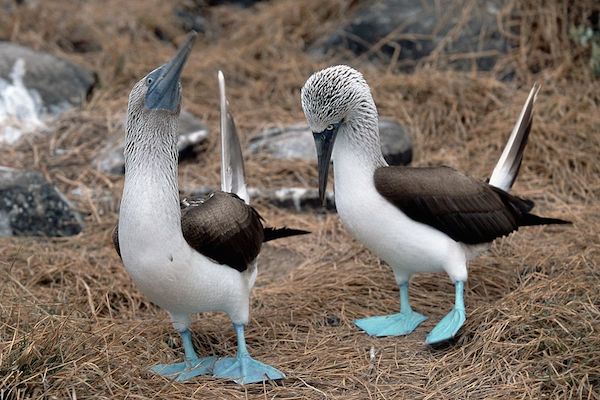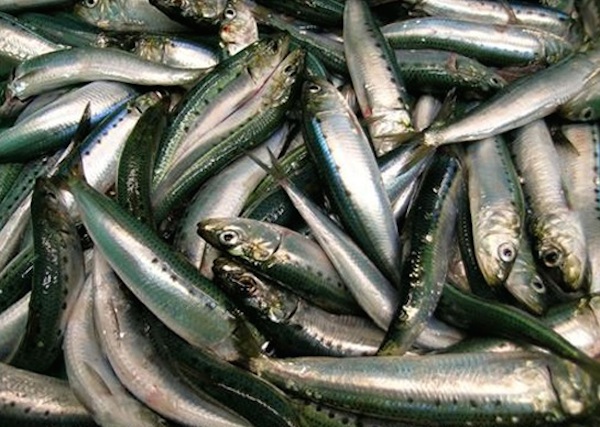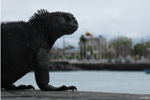Reasons for Galapagos sardine decline not known, scientists suspect overfishing or natural cycle
The iconic blue-footed booby (Sula nebouxii) of the Galapagos Islands has suffered a population decline of 50 percent in less than 20 years, according to research conducted by biologists from Wake Forest University.
The study, which appeared in the journal Avian Conservation and Ecology, suggests the unexplained disappearance of sardines from the birds’ diet is the primary reason for drop in numbers.
Professor Dave Anderson, lead investigator of the study, said that the approximate population of 6,423 boobies in 2012 is less than a third of the population recorded in the 1960s.

Despite their population drop, blue-footed boobies (Sula nebouxii) are still listed as Least Concern by the IUCN. Photo by Hans Stieglitz.
“It is alarming,” Anderson said. “There has been a drastic change from the 1980s and 1990s, when young blue-foots were common throughout the archipelago. Until 1997 there were literally thousands of boobies at breeding colonies and hundreds of nests full of hatching chicks. Then, suddenly, the boobies weren’t there.”
Relatively few booby pairs bred from 2011 to 2013, and almost no juvenile birds were observed during the study.
Researchers suspect a lack of sardines, a highly nutritious and previously easy-to-find food source, is the reason the booby population has plummeted.
Previous studies conducted at booby colonies show successful breeding occurs only when the birds had a diet consisting almost entirely of sardines. But over the course of the Galapagos study, sardines dropped to less than half of the boobies’ diet.
Johannah Barry, President of the Galapagos Conservancy, which provided funding for the study, said the next step is to ascertain why sardine numbers are dropping.
“Are they being overfished?” Barry said. “Are they leaving Galapagos waters due to climate change and other pressures? And if they are leaving, what other fauna might be impacted?”
Elsewhere in the eastern Pacific Ocean, sardine numbers have decreased significantly in the last 15 years as part of a natural cycle. This cyclic change provides a possible explanation for the decrease in booby numbers.
Anderson stressed that further studies must be undertaken soon, as two decades of booby decline means the population is aging without any younger birds to replace those that are dying.

Pacific sardines, a subspecies of the South American pilchard (Sardinops sagax) pictured here, once formed the primary component of the blue-footed booby’s diet. However, sardine numbers have declined, correlating to a decline in the booby population.
Citations:
- Anderson D (2014) Chronic lack of breeding by Galapagos Blue-footed Boobies and associated population decline. Aviation Conservation & Ecology Volume 9, Issue 1, Article 6.
Related articles
‘Hope springs eternal’: the anniversary of the death of Lonesome George

(06/24/2014) Today marks the two-year anniversary of the death of Lonesome George, the world’s last Pinta Island tortoise. The occasion calls attention to the declines of many turtle and tortoise species, which together form one of the most swiftly disappearing groups of animals on the planet.
Galapagos sea lions threatened by human exposure

(07/19/2013) A recent study conducted by the Zoological Society of London (ZSL) on endangered Galapagos sea lions (Zalophus wollebaeki) has revealed that the animals are more susceptible to starvation as a result of their exposure to humans. Over a span of more than 18 months, conservationists tagged and monitored the behavior and physiology of two groups of 60 Galapagos sea lions, one in San Cristobal, which is inhabited by humans, and one in Santa Fe, where there are no humans, dogs, cats, mice, or rats.
The Role of Science for Conservation – book review
(03/18/2013) The Role of Science for Conservation, edited by Matthias Wolff and Mark Gardner, celebrates Charles Darwin’s Bicentennial and 50 years of research by the Charles Darwin Foundation in The Galápagos, Ecuador.
Threatened Galapagos coral may predict the future of reefs worldwide

(11/07/2012) The Galapagos Islands have been famous for a century and a half, but
even Charles Darwin thought the archipelago’s list of living wonders
didn’t include coral reefs. It took until the 1970s before scientists
realized the islands did in fact have coral, but in 1983, the year the
first major report on Galapagos reef formation was published, they
were almost obliterated by El Niño. This summer, a major coral survey
found that some of the islands’ coral communities are showing
promising signs of recovery. Their struggle to survive may tell us
what is in store for the rest of the world, where almost
three-quarters of corals are predicted to suffer long-term damage by
2030.Lonesome George passes, taking unique subspecies with him

(06/25/2012) Lonesome George, the sole surviving member of the Pinta Island tortoise (Chelonoidis nigra abingdoni), was found dead on Sunday by staff at the Galapagos National Park. With George’s passing, the Pinta Island tortoise subspecies officially falls into extinction. First found in 1972, Lonesome George became famous for representing the last of his kind. He was believed to be around 100—middle-aged for a Galapagos tortoise which can live to 200 years old. Staff plan to do an autopsy to determine the cause of death.
Paradise & Paradox: a semester in Ecuador

(02/02/2011) A semester abroad is an opportunity to live a sort of compacted life. In a few short months you seem to gain the experience of a much longer time and make enough memories to fill years. I recall a weeklong trip to the Alvord Desert with a field biology class from Portland Community College: the adventure of living out of a van, conducting research, and experiencing a place with classmates turned colleagues and professors turned friends who knew the desert like the backs of their hands. In that regard, it had a lot in common with my semester in Ecuador, but I can’t think of anything that could have prepared me for a four month stay in a small South American country that I knew very little about.
Logging crisis pushes Madagascar’s forests on to UNESCO’s Danger List

(08/01/2010) UNESCO’s World Heritage committee has added Madagascar’s unique tropical forests to its Danger List of threatened ecosystems. The move comes following a drawn-out illegal logging crisis that has seen loggers and traders infiltrating the island-nation’s national parks for rosewood. Bushmeat hunting of lemurs and other rare species also accompanied the crisis.